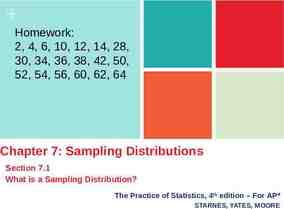CS344 : Introduction to Artificial Intelligence Pushpak Bhattacharyya
41 Slides163.00 KB
CS344 : Introduction to Artificial Intelligence Pushpak Bhattacharyya CSE Dept., IIT Bombay Lecture 15- Robotic Knowledge Representation and Inferencing; Prolog
A planning agent An agent interacts with the world via perception and actions Perception involves sensing the world and assessing the situation creating some internal representation of the world Actions are what the agent does in the domain. Planning involves reasoning about actions that the agent intends to carry out Planning is the reasoning side of acting This reasoning involves the representation of the world that the agent has, as also the representation of its actions. Hard constraints where the objectives have to be achieved completely for success The objectives could also be soft constraints, or preferences, to be achieved as much as possible
Interaction with static domain The agent has complete information of the domain (perception is perfect), actions are instantaneous and their effects are deterministic. The agent knows the world completely, and it can take all facts into account while planning. The fact that actions are instantaneous implies that there is no notion of time, but only of sequencing of actions. The effects of actions are deterministic, and therefore the agent knows what the world will be like after each action.
Two kinds of planning Projection into the future The planner searches through the possible combination of actions to find the plan that will work Memory based planning looking into the past The agent can retrieve a plan from its memory
Planning Definition : Planning is arranging a sequence of actions to achieve a goal. Uses core areas of AI like searching and reasoning & Is the core for areas like NLP, Computer Vision. Robotics Kinematics (ME) Planning (CSE) Examples : Navigation , Manoeuvring, Language Processing (Generation)
Language & Planning Non-linguistic representation for sentences. agent I see object movie Sentence generation Word order determination (Syntax planning) E.g. I see movie ( English) I movie see (Intermediate Language)
STRIPS Stanford Research Institute Problem Solver (1970s) Planning system for a robotics project : SHAKEY (by Nilsson et.al.) Knowledge Representation : First Order Logic. Algorithm : Forward chaining on rules. Any search procedure : Finds a path from start to goal. Forward Chaining : Data-driven inferencing Backward Chaining : Goal-driven
Forward & Backward Chaining Rule : man(x) mortal(x) Data : man(Shakespeare) To prove : mortal(Shakespeare) Forward Chaining: man(Shakespeare) matches LHS of Rule. X Shakespeare mortal( Shakespeare) added -Forward Chaining used by design expert systems Backward Chaining: uses RHS matching - Used by diagnostic expert systems
Example : Blocks World STRIPS : A planning system – Has rules with precondition deletion list and addition list Robot hand C A A B C B START Sequence of actions : 1. Grab C 2. Pickup C 3. Place on table C 4. Grab B 5. Pickup B Robot hand GOAL 6. 7. 8. 9. Stack B on C Grab A Pickup A Stack A on B
Example : Blocks World Fundamental Problem : The frame problem in AI is concerned with the question of what piece of knowledge is relevant to the situation. Fundamental Assumption : Closed world assumption If something is not asserted in the knowledge base, it is assumed to be false. (Also called “Negation by failure”)
Example : Blocks World STRIPS : A planning system – Has rules with precondition deletion list and addition list Robot hand C A B START on(B, table) on(A, table) on(C, A) hand empty clear(C) clear(B) A B C GOAL on(C, table) on(B, C) on(A, B) hand empty clear(A) Robot hand
Rules R1 : pickup(x) Precondition & Deletion List : hand empty, on(x,table), clear(x) Add List : holding(x) R2 : putdown(x) Precondition & Deletion List : holding(x) Add List : hand empty, on(x,table), clear(x)
Rules R3 : stack(x,y) Precondition & Deletion List :holding(x), clear(y) Add List : on(x,y), clear(x) R4 : unstack(x,y) Precondition & Deletion List : on(x,y), clear(x) Add List : holding(x), clear(y)
Plan for the block world problem For the given problem, Start Goal can be achieved by the following sequence : 1. Unstack(C,A) 2. Putdown(C) 3. Pickup(B) 4. Stack(B,C) 5. Pickup(A) 6. Stack(A,B) Execution of a plan: achieved through a data structure called Triangular Table.
Triangular Table on(C,A) 1 clear(C) hand empty unstack(C,A) holding(C) 2 3 on(B,table) hand empty clear(C) 4 5 putdown(C) on(A,table) pickup(B) holding(B) clear(A) stack(B,C) hand empty 6 clear(B) on(C,table) 7 0 1 2 pickup(A) holding(A) on(B,C) 3 4 stack(A,B) on(A,B) clear(A) 5 6
Triangular Table For n operations in the plan, there are : (n 1) rows : 1 n 1 (n 1) columns : 0 n At the end of the ith row, place the ith component of the plan. The row entries for the ith step contain the pre-conditions for the ith operation. The column entries for the jth column contain the add list for the rule on the top. The i,j th cell (where 1 i n 1 and 0 j n) contain the preconditions for the ith operation that are added by the jth operation. The first column indicates the starting state and the last row indicates the goal state.
Search in case of planning Start Ex: Blocks world Pickup(B) S1 Unstack(C,A) S2 Triangular table leads to some amount of fault-tolerance in the robot NOT ALLOWED C A B START A B C A C B WRONG MOVE
Resilience in Planning After a wrong operation, can the robot come back to the right path ? i.e. after performing a wrong operation, if the system again goes towards the goal, then it has resilience w.r.t. that operation Advanced planning strategies Hierarchical planning Probabilistic planning Constraint satisfaction
Prolog Programming
Introduction PROgramming in LOGic Emphasis on what rather than how Problem in Declarative Form Logic Machine Basic Machine
Prolog’s strong and weak points Assists thinking in terms of objects and entities Not good for number crunching Useful applications of Prolog in Expert Systems (Knowledge Representation and Inferencing) Natural Language Processing Relational Databases
A Typical Prolog program Compute length ([],0). Compute length ([Head Tail], Length):Compute length (Tail,Tail length), Length is Tail length 1. High level explanation: The length of a list is 1 plus the length of the tail of the list, obtained by removing the first element of the list. This is a declarative description of the computation.
Fundamentals (absolute basics for writing Prolog Programs)
Facts John likes Mary like(john,mary) Names of relationship and objects must begin with a lower-case letter. Relationship is written first (typically the predicate of the sentence). Objects are written separated by commas and are enclosed by a pair of round brackets. The full stop character ‘.’ must come at the end of a fact.
More facts Predicate Interpretation valuable(gold) Gold is valuable. owns(john,gold) John owns gold. father(john,mary) John is the father of Mary John gives the book to Mary gives (john,book,mary)
Questions Questions based on facts Answered by matching Two facts match if their predicates are same (spelt the same way) and the arguments each are same. If matched, prolog answers yes, else no. No does not mean falsity.
Prolog does theorem proving When a question is asked, prolog tries to match transitively. When no match is found, answer is no. This means not provable from the given facts.
Variables Always begin with a capital letter ?- likes (john,X). ?- likes (john, Something). But not ?- likes (john,something)
Example of usage of variable Facts: likes(john,flowers). likes(john,mary). likes(paul,mary). Question: ?- likes(john,X) Answer: X flowers and wait ; mary ; no
Conjunctions Use ‘,’ and pronounce it as and. Example Facts: likes(mary,food). likes(mary,tea). likes(john,tea). likes(john,mary) ? likes(mary,X),likes(john,X). Meaning is anything liked by Mary also liked by John?
Backtracking (an inherent property of prolog programming) likes(mary,X),likes(john,X) likes(mary,food) likes(mary,tea) likes(john,tea) likes(john,mary) 1. First goal succeeds. X food 2. Satisfy likes(john,food)
Backtracking (continued) Returning to a marked place and trying to resatisfy is called Backtracking likes(mary,X),likes(john,X) likes(mary,food) likes(mary,tea) likes(john,tea) likes(john,mary) 1. Second goal fails 2. Return to marked place and try to resatisfy the first goal
Backtracking (continued) likes(mary,X),likes(john,X) likes(mary,food) likes(mary,tea) likes(john,tea) likes(john,mary) 1. First goal succeeds again, X tea 2. Attempt to satisfy the likes(john,tea)
Backtracking (continued) likes(mary,X),likes(john,X) likes(mary,food) likes(mary,tea) likes(john,tea) likes(john,mary) 1. Second goal also suceeds 2. Prolog notifies success and waits for a reply
Rules Statements about objects and their relationships Expess If-then conditions Generalizations I use an umbrella if there is a rain use(i, umbrella) :- occur(rain). All men are mortal mortal(X) :- man(X). Definitions An animal is a bird if it has feathers bird(X) :- animal(X), has feather(X).
Syntax head :- body Read ‘:-’ as ‘if’. E.G. likes(john,X) :- likes(X,cricket). “John likes X if X likes cricket”. i.e., “John likes anyone who likes cricket”. Rules always end with ‘.’.
Another Example sister of (X,Y):- female (X), parents (X, M, F), parents (Y, M, F). X is a sister of Y is X is a female and X and Y have same parents
Question Answering in presence of rules Facts male (ram). male (shyam). female (sita). female (gita). parents (shyam, gita, ram). parents (sita, gita, ram).
Question Answering: Y/N type: is sita the sister of shyam? ?- sister of (sita, shyam) female(sita) parents(sita,M,F) parents(shyam,M,F) parents(shyam,gita,ram) parents(sita,gita,ram) success
Question Answering: wh-type: whose sister is sita? ?- ?- sister of (sita, X) female(sita) parents(sita,M,F) parents(Y,M,F) parents(Y,gita,ram) parents(sita,gita,ram) parents(shyam,gita,ram) Success Y shyam
Exercise 1. From the above it is possible for somebody to be her own sister. How can this be prevented?














































